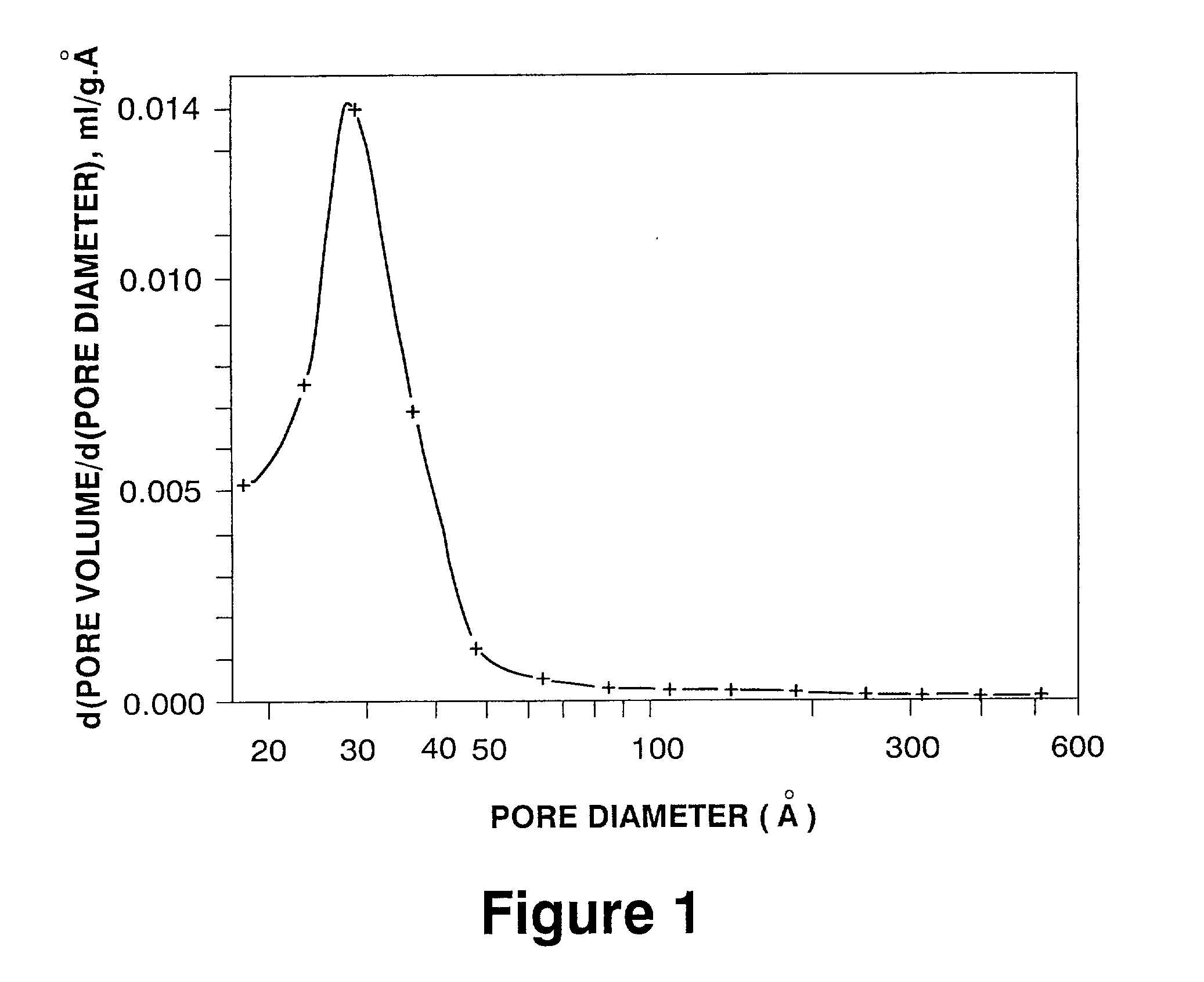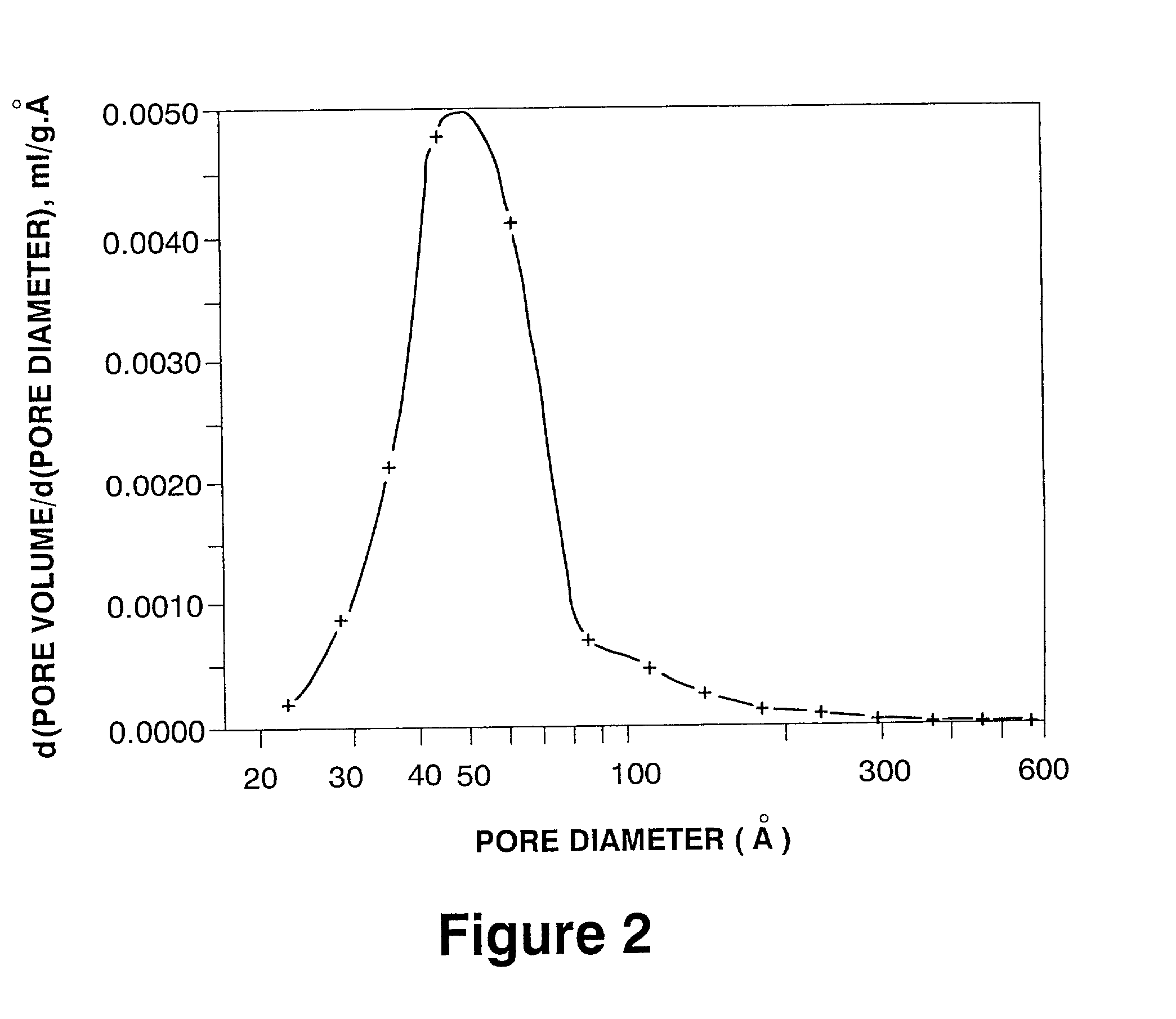Modified aluminas and the use thereof in FCC catalysts
- Summary
- Abstract
- Description
- Claims
- Application Information
AI Technical Summary
Benefits of technology
Problems solved by technology
Method used
Image
Examples
example 1
[0032] Preparation of Modified Aluminas
[0033] The starting hydrated alumina was gibbsite. It was obtained from Alcoa Aluminum of Brazil S.A. and designated C-30. Before reaction it was milled to particle sizes of less than 100 microns. To 100 g (dry basis--815.degree. C. / 1 hr) of the gibbsite particles placed in a glass sheathed reactor were added 549 g of aqueous acetic acid (54.6 weight percent of acetic acid in water). The reaction mixture was stirred continuously, with its temperature being kept at 98.degree. C., and under these conditions the reaction was allowed to proceed for 6 hours. At the end of this period, the suspension was filtered, and the solids were successively washed with portions of warm, demineralized water (total amoun5 of water used: 4.51) The washed product was dried in the oven at 120.degree. C. for 17 hrs. X-ray diffraction analysis indicated that the product was made up of a mixture of basic aluminum acetate and unreacted gibbsite. X-ray fluorescence analy...
example 2
[0036] Preparation of Modified Aluminas
[0037] The preparation procedure (reaction, washing, and drying) was the same as that described in Example 1, except that the reaction was allowed to proceed for 18 hrs. X-ray fluorescence analysis showed that the dried product contained 44 wt % of Al.sub.2O.sub.3 indicating that 37 percent of the gibbsite had remained unreacted and that 63 percent had been converted to basic aluminum acetate salt. A portion of the dried material was calcined at 788.degree. C. for 3 hrs. The calcined product had a surface area of 110 m.sup.2 / g and a pore volume of 0.32 ml / g.
example 3
[0038] Preparation of Modified Aluminas
[0039] The preparation procedure (reaction, washing, and drying) was the same as that described in Example 1, except that the reaction was allowed to proceed for 65 hrs. X-ray fluorescence showed that the dried product contained 39 wt. % of Al.sub.2O.sub.3, indicating that 22 percent of the gibbsite had remained unreacted and that 78 percent had been converted to basic aluminum acetate.
[0040] A portion of the dried material was calcined at 550.degree. C. for 3 hours. The pore size distribution of the calcined product (nitrogen adsorption; derivative curve) showed two maxima: one at a pore diameter of 3.6 nm, the other at a pore diameter of 10.1 nm.
[0041] Another portion of the dried material was calcined at 788.degree. C. for 3 hrs. The calcined product had a surface area of 130 m.sup.2 / g, a pore volume of 0.46 ml / g, and a pore size distribution (nitrogen adsorption; derivative curve) with maxima at pore diameters of 5.0 nm and 10.1 nm.
PUM
| Property | Measurement | Unit |
|---|---|---|
| Fraction | aaaaa | aaaaa |
| Time | aaaaa | aaaaa |
| Time | aaaaa | aaaaa |
Abstract
Description
Claims
Application Information
 Login to view more
Login to view more - R&D Engineer
- R&D Manager
- IP Professional
- Industry Leading Data Capabilities
- Powerful AI technology
- Patent DNA Extraction
Browse by: Latest US Patents, China's latest patents, Technical Efficacy Thesaurus, Application Domain, Technology Topic.
© 2024 PatSnap. All rights reserved.Legal|Privacy policy|Modern Slavery Act Transparency Statement|Sitemap


